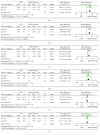Efficacy and Safety of Argon Laser Peripheral Iridoplasty and Systemic Medical Therapy in Asian Patients with Acute Primary Angle Closure: A Meta-Analysis of Randomized Controlled Trials
- PMID: 31192000
- PMCID: PMC6525875
- DOI: 10.1155/2019/7697416
Efficacy and Safety of Argon Laser Peripheral Iridoplasty and Systemic Medical Therapy in Asian Patients with Acute Primary Angle Closure: A Meta-Analysis of Randomized Controlled Trials
Abstract
Purpose: The purpose of this meta-analysis was to assess the percent reduction in the intraocular pressure (IOP) after argon laser peripheral iridoplasty (ALPI) and systemic medical therapy in patients with acute primary angle closure (APAC).
Methods: We searched a number of electronic databases, including MEDLINE, EMBASE, PubMed, and Cochrane Library. We searched the electronic databases from the inception of the databases to August 2018. The primary outcomes included the IOP reduction (IOPR), percent reduction in IOP (IOPR%) from baseline to the endpoint and peripheral anterior synechiae (PAS). The secondary outcomes included the cup-to-disc ratio (CDR), mean endothelial count, and percent of patients requiring topical glaucoma medication. Summary weighted mean difference (WMD), odds ratio (OR), and 95% confidence intervals (CIs) were calculated.
Results: Four eligible studies including 183 eyes (92 in the ALPI group and 91 in the medical therapy group) were identified. When comparing ALPI to medical therapy, the WMDs of the IOPR% were 30.03 (95% CI: 21.33 to 38.72, p < 0.00001) at 15 minutes, 27.39 (95% CI: 18.89 to 35.89, p < 0.00001) at 30 minutes, 18.15 (95% CI: 10.63 to 25.68, p < 0.00001) at 1 hour, and 12.91 (95% CI: 4.50 to 21.32, p=0.003) at 2 hours. There was no statistically significant difference between the two groups at 24 hours and at more than 6 months after therapy. Meanwhile, no significant difference was observed in the degree of PAS, CDR, mean endothelial count, and percent of patients requiring topical glaucoma medication after treatment between the two groups.
Conclusions: Both ALPI and systemic medications were effective with regard to decreasing the IOP. ALPI was more effective in lowering the IOP within the first two hours. Therefore, ALPI may be a better choice for rapidly lowering the IOP in patients with APAC within a short period.
Figures







Similar articles
-
Argon laser peripheral iridoplasty versus conventional systemic medical therapy in treatment of acute primary angle-closure glaucoma : a prospective, randomized, controlled trial.Ophthalmology. 2002 Sep;109(9):1591-6. doi: 10.1016/s0161-6420(02)01158-2. Ophthalmology. 2002. PMID: 12208703 Clinical Trial.
-
Laser peripheral iridoplasty for chronic angle closure.Cochrane Database Syst Rev. 2021 Mar 23;3(3):CD006746. doi: 10.1002/14651858.CD006746.pub4. Cochrane Database Syst Rev. 2021. PMID: 33755197 Free PMC article.
-
Argon laser peripheral iridoplasty versus systemic intraocular pressure-lowering medications as immediate management for acute phacomorphic angle closure.Clin Ophthalmol. 2013;7:63-9. doi: 10.2147/OPTH.S39503. Epub 2013 Jan 9. Clin Ophthalmol. 2013. PMID: 23326185 Free PMC article.
-
Argon Laser Peripheral Iridoplasty for Primary Angle-Closure Glaucoma: A Randomized Controlled Trial.Ophthalmology. 2016 Mar;123(3):514-21. doi: 10.1016/j.ophtha.2015.11.002. Epub 2015 Dec 23. Ophthalmology. 2016. PMID: 26707418 Clinical Trial.
-
Ab interno trabecular bypass surgery with iStent for open-angle glaucoma.Cochrane Database Syst Rev. 2019 Mar 28;3(3):CD012743. doi: 10.1002/14651858.CD012743.pub2. Cochrane Database Syst Rev. 2019. PMID: 30919929 Free PMC article.
Cited by
-
Trabeculectomy versus stepwise treatment for breaking the attack of acute primary angle closure in patients with long attack duration: study design and protocol for a multicentre randomised controlled trial (LAAAC).BMJ Open Ophthalmol. 2025 Feb 6;10(1):e001934. doi: 10.1136/bmjophth-2024-001934. BMJ Open Ophthalmol. 2025. PMID: 39915238 Free PMC article.
-
Clinical implication of recent randomized control trial in primary angle-closure disease management.Indian J Ophthalmol. 2022 Aug;70(8):2825-2834. doi: 10.4103/ijo.IJO_1807_21. Indian J Ophthalmol. 2022. PMID: 35918922 Free PMC article. Review.
References
Publication types
LinkOut - more resources
Full Text Sources

